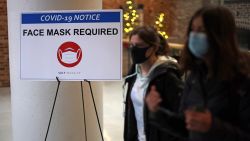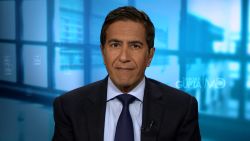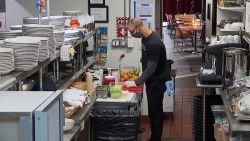A version of this story first appeared in CNN Business’ Before the Bell newsletter. Not a subscriber? You can sign up right here.
JPMorgan Chase (JPM), the biggest US bank, has dramatically changed its economic forecast for the next year. And it’s bleak.
“There is no longer doubt that the longest global expansion on record will end this quarter,” Bruce Kasman, the bank’s head of economic research, told clients on Wednesday. “The key outlook issue now is gauging the depth and the duration of the 2020 recession.”
JPMorgan now believes that China’s economy will shrink by 40% compared to the previous quarter between January and March, the biggest contraction recorded over the past 50 years at least. That will reverberate across Asia.
The shock to the United States and Europe, meanwhile, is expected to be concentrated between April and June as daily life grinds to a standstill. The bank thinks US GDP will shrink an annualized rate of 14% in the second quarter, far worse than in the fourth quarter of 2008, which yielded the steepest contraction of the Great Recession.
JPMorgan predicts this will force the US unemployment rate up from 3.5% to 6.25% by the middle of the year, before falling to 5.25% by the end of 2020.
The situation looks even worse in Europe, which is now the epicenter of the pandemic. The eurozone economy is forecast to shrink 22% during the second quarter, while the UK economy is expected to contract 30%.
That’s even with the understanding that stimulus efforts from central banks and governments is building.
The European Central Bank on Wednesday announced a huge new money-printing program. It said it would spend €750 billion ($821 billion) buying government debt and private securities before the end of 2020, and stands ready to do even more if necessary. But even that action has failed to steady stock markets, which fell again in much of Europe in early trading.
JPMorgan still predicts a significant rebound in the second half of the year, but notes that in the current environment, it’s hard to say for sure.
“If a normalization in activity from depressed levels takes hold midyear alongside building policy stimulus, the depth of the current downturn can be seen as a springboard for a strong snapback in growth,” Kasman said. “However, there is a significant risk that the virus outbreak persists and activity remains restricted for a longer time.”
The updated forecasts from the bank — which has global growth contracting 12% in the first quarter and 1.2% for the second quarter, as China gets its economy back on track — is among the most dire published by Wall Street.
It’s a sign of how rapidly the situation is changing, and how investors are still racing to catch up to complete shutdowns in large parts of the world. Earlier this week, Goldman Sachs predicted that US GDP would shrink 5% in the second quarter of the year.
‘Dash for cash’: The US dollar plows ahead
There’s only one currency that investors want to hold right now, and that’s the US dollar.
The ultimate safe haven investment is surging as companies and investors scramble for cash, with economic and financial uncertainty tied to the coronavirus pandemic reaching new heights.
“The primary driving force in [currency] markets remains the ‘dash for cash,’” James Rossiter, head of global macro strategy at TD Securities, told clients on Thursday. “The cash the market wants most is the US dollar.”
The US Dollar Index has climbed to its highest level in three years. That’s come at the expense of other currencies; the British pound is hovering around $1.15, close to its lowest level since 1985.
Even the Japanese yen, another traditional safe haven investment, has suffered, weakening 0.9% against the US dollar on Thursday.
Societe Generale strategist Kit Juckes warns that central banks will need to deal with the shortage of dollars promptly in order for currency markets to stabilize.
Earlier this week, the US Federal Reserve struck a deal with five other foreign central banks — the Bank of Canada, the Bank of England, the Bank of Japan, the European Central Bank and the Swiss National Bank — to lower their rates on currency swaps, the first time its taken such action since the European debt crisis in 2011. This made borrowing US dollars cheaper for banks around the world.
What’s next: The Fed could make swap lines available to a broader basket of countries, easing the global cash crunch, Brad Setser, an economist at the Council on Foreign Relations, wrote in a recent blog post.
The New York Stock Exchange trading floor is closing
The New York Stock Exchange is temporarily closing trading floors and moving to fully electronic trading next week to prevent the spread of coronavirus, my CNN Business colleague Clare Duffy reports.
The announcement comes shortly after the NYSE sent an update to traders informing them that two people who work at the exchange tested positive for Covid-19, the illness caused by the novel coronavirus.
The NYSE had been screening anyone who came into the building. Both individuals who tested positive were screened on Monday and barred entry.
What’s next: The markets will continue to operate under normal trading hours despite the floor closures. But it’s a symbolic blow that shows the extent to which all parts of American life — including country’s financial system — have been rocked by the virus.
Up next
US unemployment insurance claims for the past week arrive at 8:30 a.m. ET, an early look at the damage to the job market.
The Economic Policy Institute, a left-leaning think tank, predicts that 3 million jobs will be lost by the summer even with “moderate” stimulus spending.



























